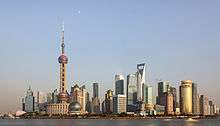Trams in Shanghai
Trams in Shanghai began operating in 1908 using a steel wheeled electric system, but had been discontinued by the mid-1970s.
In 2010, the Zhangjiang Tram reintroduced this form of transport to Shanghai in the form of a single line in a planned area on the outskirts of the metropolitan area.
History




Three tramway systems
In the early 20th century Shanghai was served by three tram companies: the British system, which opened on March 15, 1908, was the largest with seven routes and 216 trams; the French system, which opened in May, 1908, had three routes and 60 trams; the Chinese company opened on August 11, 1913, and operated 52 trams on four routes totaling 23.5 km in length.[1] Routes were built step by step, and it reached their maximum in 1925 with 328 tramcars and 14 routes.
Increasingly congested and inconvenient
Starting from the mid-1950s, traffic congestion grew rapidly. The number of buses, taxis and private cars increased rapidly, taking over more streetspace. Tramcars were not modernized for many decades, and basically the 1930s electric cars were still running in the 1970s. At that time buses accelerated more quickly and gave a smoother journey, whereas trams were slower, 'single coach', and had many old-fashioned features, like trolley poles, and so looked outdated.
Poor maintenance of the tracks caused some derailments and bumpy rides, which were not liked by commuters. After the war between China and Japan, reconstruction of Shanghai became urgent, and for this program, many streets needed to be widened. The transport authority thought that slow tram transport, together with fast bus transport, in the middle of a wide road, would impede smooth city transportation.
Closure of the original system
Shanghai's tram system originally had been one of the most modern in Asia. There were two closed-design coaches, and electricity was supplied from overhead cables. However, the tramway had very little further upgrading, and basically the 1930s electric cars were still running in the 1970s. These vehicles looked outdated compared to the new cars and buses that were then on the streets. That seemed like a good reason for closing the system.
There were a number of other reasons for closing the original tram system:
- All tram routes were on unreserved tracks
- The tracks were outdated, noisy and in the middle of the street
- Cars had to pass the tramway on the right, causing danger for the pedestrians boarding and alighting from the tramway
- Tramcars were caught in the traffic jam caused by the cars and rickshaws
After closing the tram network in the early 1970s, the people of Shanghai thought that the only obstacle to smooth city traveling had been removed, and the city could move faster than before, but it proved false some years later. The uncontrolled increase of petrol fueled vehicles, like buses, taxicabs, and private cars started choking the streets.
Renewed urban problems
Like most Asian countries, China suffered many of the problems of developing countries, including pollution, traffic jams, illegal migration, low literacy and booming increase of population. The increasing population increased the urbanization of Shanghai, and increased motor vehicle traffic, which increased air and noise pollution, traffic jams and smog.
Reconsideration of trams
After all these problems appeared in mid-1990s, the inhabitants of Shanghai realized that not controlling motor vehicles, and closing down the trams, had been a great mistake. Many cities around the world like Tunis, Sydney, Buenos Aires, Pyongyang, Nottingham etc. also understood that error and, like them, another Chinese city Tianjin also returned to using trams. Following Tianjin's example, Shanghai planned to reintroduce its tram system.
Downtown Shanghai was so overcrowded by motor vehicles around 2000, that opening a tramway system was not possible, so the transport authority decided to construct it in the Zhangjiang, which is on the eastern side of the main city.
Depots , routes and terminals
The shopping district was the main tram junction where three lines were connected or crossed.
See also
|
References
- ↑ Warr, Anne: Shanghai Architecture, The Watermark Press, 2007, ISBN 978-0-949284-76-1
